Lithuanians
Lietuviai | |
|---|---|
 | |
| Total population | |
| c. 4.2 million[1] | |
| Regions with significant populations | |
| 652,790 (2014)[a][3] | |
| 212,000 (2018)[4] | |
| 200,000 (2002)[5][6] | |
| 85,617 (2014)[6] | |
| 75,000 (2021)[7] | |
| 62,239 (2014)[6] | |
| 59,285 (2016)[8] | |
| 50,406 (2023)[9] | |
| 42,973 (2022)[7] | |
| 34,846 (2014)[6] | |
| 22,012 (2021)[b][c][11] | |
| 20,000[d][13] | |
| 19,954 (2014)[6] | |
| 19,091 (2014)[6] | |
| 17,991 (2022)[7] | |
| 17,396 (2022)[14] | |
| 16,429 (2023)[15] | |
| 10,119 (2022)[7] | |
| 10,000[16] | |
| Languages | |
| Lithuanian | |
| Religion | |
| Roman Catholicism (majority), Lutheranism and Irreligion (minority) | |
| Related ethnic groups | |
| Other Balts | |
Lithuanians (
History
This section needs expansion. You can help by adding to it. (September 2023) |
"We do not know on whose merits or guilt such a decision was made, or with what we have offended Your Lordship so much that Your Lordship has deservedly been directed against us, creating hardship for us everywhere. First of all, you made and announced a decision about the land of Samogitia, which is our inheritance and our homeland from the legal succession of the ancestors and elders. We still own it, it is and has always been the same Lithuanian land, because there is one language and the same inhabitants. But since the land of Samogitia is located lower than the land of Lithuania, it is called as Samogitia, because in Lithuanian it is called lower land [ Žemaitija ]. And the Samogitians call Lithuania as Aukštaitija, that is, from the Samogitian point of view, a higher land. Also, the people of Samogitia have long called themselves Lithuanians and never – Samogitians, and because of such identity (sic) we do not write about Samogitia in our letter, because everything is one: one country and the same inhabitants."
—


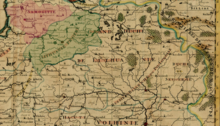
The territory of the Balts, including modern Lithuania, was once inhabited by several Baltic tribal entities (
There is a current argument that the Lithuanian language was considered non-prestigious enough by some elements in Lithuanian society, meaning that the number of Lithuanian language-speakers decreased with
Some of the Polish- and Belarusian-speaking persons from the lands of the former Grand Duchy of Lithuania expressed their affiliation with the modern Lithuanian nation in the early 20th century, including Michał Pius Römer, Stanisław Narutowicz, Oscar Milosz and Tadas Ivanauskas
In February 1918, while World War I was ongoing, the re-establishment of an independent Lithuanian state was declared, 122 years after it was destroyed. In the aftermath of World War I, Lithuanians militarily defended their country's independence from Poland, Whites and Soviet Russia during the Lithuanian Wars of Independence. However, a third of Lithuania's lands, namely the Vilnius Region, as well as its declared capital, fell under Polish occupation during the Interwar. A standardised Lithuanian language was approved. In the lead-up to the World War II, the Klaipėda Region was occupied by Nazi Germany after the 1939 German ultimatum to Lithuania.
The territory inhabited by the ethnic Lithuanians has shrunk over centuries; once Lithuanians made up a majority of the population not only in what is now Lithuania, but also in northwestern Belarus, in large areas of the territory of the modern Kaliningrad Oblast of Russia, and in some parts of modern Latvia and Poland.[27]
In 1940, Lithuania was invaded and occupied by the
The Lithuanian nation as such remained primarily in Lithuania, few villages in northeastern Poland, southern Latvia and also in the diaspora of emigrants. Some indigenous Lithuanians still remain in Belarus and the Kaliningrad Oblast, but their number is small compared to what they used to be. Lithuania regained its independence in 1990, and was recognized by most countries in 1991. It became a member of the European Union on May 1, 2004.[citation needed]
Ethnic composition of Lithuania
Among the Baltic states, Lithuania has the most homogeneous population. According to the census conducted in 2001, 83.45% of the population identified themselves as ethnic Lithuanians, 6.74% as Poles, 6.31% as Russians, 1.23% as Belarusians, and 2.27% as members of other ethnic groups such as Ukrainians, Jews, Germans, Tatars, Latvians, Romani, Estonians, Crimean Karaites etc.
Poles are mostly concentrated in the Vilnius County. Especially large Polish communities are located in the Vilnius District Municipality and the Šalčininkai District Municipality.
Despite being the capital, Vilnius was not the largest city by number of Lithuanians until mid-2000s. According to the 2011 census Vilnius had 337,000 Lithuanians while Kaunas – 316,000.[28]
Russians, even though they are almost as numerous as Poles, are much more evenly scattered. The most prominent community lives in the Visaginas Municipality (52%). Most of them are workers who moved from Russia to work at the Ignalina Nuclear Power Plant. A number of ethnic Russians left Lithuania after the declaration of independence in 1990.
In the past, the ethnic composition of Lithuania has varied dramatically. The most prominent change was the extermination of the Jewish population during the Holocaust. Before World War II, about 7.5% of the population was Jewish[citation needed]; they were concentrated in cities and towns and had a significant influence on crafts and business. They were called Litvaks and had a strong culture. The population of Vilnius, which was sometimes nicknamed the northern Jerusalem, was about 30% Jewish.[citation needed] Almost all its Jews were killed during the Holocaust in Nazi-occupied Lithuania, some 75,000 alone between the years 1941 – 1942,[29] while others later immigrated to the United States and Israel. Now there are about 3,200 Jews living in Lithuania.[30]

Cultural subgroups
Apart from the various religious and ethnic groups currently residing in Lithuania, Lithuanians themselves retain and differentiate between their regional identities; there are 5 historic regional groups:
Genetics
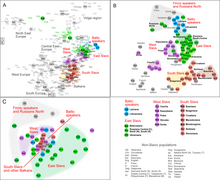
Since the late Neolithic period the native inhabitants of the Lithuanian territory have not been replaced by migrations from outside, so there is a high probability that the inhabitants of present-day Lithuania have preserved the genetic composition of their forebears relatively undisturbed by the major demographic movements,[32] although without being actually isolated from them.[33] The Lithuanian population appears to be relatively homogeneous, without apparent genetic differences among ethnic subgroups.[34]
A 2004 analysis of
Lithuanian
At the end of the 19th century, the average height of males was 163.5 cm (5 ft 4 in) and the average height of females was 153.3 cm (5 ft 0 in). By the end of the 20th century, heights averaged 181.3 cm (5 ft 11 in) for males and 167.5 cm (5 ft 6 in) for females.[39]
Diaspora
This section needs additional citations for verification. (January 2021) |
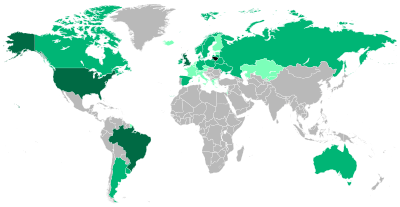
Lithuanian settlement extends into adjacent countries that are now outside the modern Lithuanian state. A small Lithuanian community exists in the vicinity of Puńsk and Sejny in the Suwałki area of Poland, an area associated with the Lithuanian writer and cleric Antanas Baranauskas.[40] Although most of the Lithuanian inhabitants in the region of Lithuania Minor that formed part of East Prussia were expelled when the area was annexed by the Soviet Union as the Kaliningrad Oblast, small groups of Lithuanians subsequently settled that area as it was repopulated with new Soviet citizens. Small groups of Lithuanians are still present in Belarus within the Grodno and Vitebsk regions.[41]
Apart from the traditional communities in Lithuania and its neighboring countries, Lithuanians have emigrated to other continents during the 19th, 20th and 21st centuries.
- Communities in the United States make up the largest part of this diaspora; as many as one million Americans can claim Lithuanian descent. Emigration to America began in the 19th century, with the generation calling itself the "grynoriai" (derived from "greenhorn" meaning new and inexperienced).[42] The migration flow was interrupted during the Soviet occupation, when travel and emigration were severely restricted. The largest concentrations of Lithuanian Americans are in the Great Lakes area and the Northeast; Chicago in particular is noted as the primary center of the diaspora. Nearly 33,000 Lithuanians have immigrated to the United States since the fall of the Soviet Union in 1991.[43]
- Lithuanian communities in Canada are among the largest in the world along with the United States (See Lithuanian Canadian).
- Lithuanian communities in Mexico and South America (Lithuanians in Brazil).
- Lithuanian communities were formed in South Africa during the late 19th and 20th century, the majority being Jewish.
- Lithuanian communities in other regions of the former Soviet Union were formed during the Soviet occupation; the numbers of Lithuanians in Siberia and Central Asia increased dramatically when a large portion of Lithuanians were involuntarily deported into these areas. After de-Stalinization, however, most of them returned. Later, some Lithuanians were relocated to work in other areas of the Soviet Union; some of them did not return to Lithuania, after it became independent.
- The Lithuanian communities in United Kingdom and Ireland began to appear after the restoration of independence to Lithuania in 1990; this emigration intensified after Lithuania became part of the European Union in 2004. London and Glasgow (especially the Bellshill and Coatbridge areas of Greater Glasgow) have long had large Catholic and Jewish Lithuanian populations. The Republic of Ireland probably has the highest concentration of Lithuanians relative to its total population size in Western Europe; its estimated 45,000 Lithuanians (about half of whom are registered) form over 1% of Ireland's total population.
- The Lithuanian communities in other countries of Northwestern Europe (Norway, Sweden, Denmark, the Netherlands, and Iceland) as well as in Spain are very new and began their growth spurts as Lithuanian was accepted into the EU. In Norway there are 45,415 Lithuanians living in the country and it has in a short time become the second largest ethnic minority in the country, making up 0.85% of Norway's total population, and 4.81% of all foreign residents in Norway.[44] There are around 3,500 Lithuanians in Iceland, making around 1% of the total population.
- Lithuanian communities in Germany began to appear after World War II. In 1950 they founded the Lithuanian High School in Diepholz, which was a private school for children of Lithuanian refugees. For decades the Lithuanian High School was the only full-time high school outside the Eastern Bloc offering courses in Lithuanian history, language, and culture. In 1954, the Lithuanian Community acquired Rennhof Manor House with its twelve-acre park in the town of Lampertheim-Hüttenfeld. The school was relocated there and still exists today.
- Lithuanian communities in Australia exist as well; due to its great distance from Europe, however, emigration there was minuscule. There are Lithuanian communities in Melbourne, Geelong, Sydney, Adelaide, Brisbane, Hobart and Perth.
Culture and traditions
The Lithuanian national sport is usually considered to be
Cuisine
Lithuanian cuisine has much in common with other European cuisines and features the products suited to its cool and moist northern climate: barley, potatoes, rye, beets, greens, and mushrooms are locally grown, and dairy products are one of its specialties. Nevertheless, it has its own distinguishing features, which were formed by a variety of influences during the country's rich history.[citation needed]
Since shared similarities in history and heritage, Lithuanians, Jews and Poles have developed many similar dishes and beverages: dumplings ( koldūnai), doughnuts (spurgos), and crepes (lietiniai blynai). German traditions also influenced Lithuanian cuisine, introducing pork and potato dishes, such as potato pudding (
For Lithuanian Americans both traditional Lithuanian dishes of
There are also regional cuisine dishes, e.g. traditional
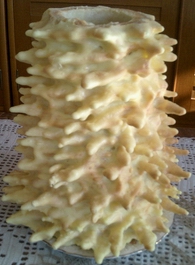
Lithuanians in the early 20th century were among the thinnest people in the developed countries of the world.[45] In Lithuanian cuisine there is some emphasis on attractive presentation of freshly prepared foods.
Lithuania has been brewing midus, a type of Lithuanian mead for thousands of years.[46]
Locally brewed beer (alus), vodka (degtinė), and kvass (gira) are popular drinks in Lithuania. Lithuanian traditional beer of Northern Lithuania, Biržai, Pasvalys regions is well appreciated in Lithuania and abroad.[47] Starka is a part of the Lithuanian heritage, still produced in Lithuania.
Language
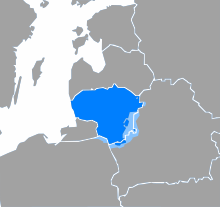
Among
Literature
When the ban against printing the Lithuanian language was lifted in 1904, various European literary movements such as Symbolism, impressionism, and expressionism each in turn influenced the work of Lithuanian writers. The first period of Lithuanian independence (1918–1940) gave them the opportunity to examine themselves and their characters more deeply, as their primary concerns were no longer political. An outstanding figure of the early 20th century was Vincas Krėvė-Mickevičius, a novelist and dramatist. His many works include Dainavos šalies senų žmonių padavimai (Old Folks Tales of Dainava, 1912) and the historical dramas Šarūnas (1911), Skirgaila (1925), and Mindaugo mirtis (The Death of Mindaugas, 1935). Petras Vaičiūnas was another popular playwright, producing one play each year during the 1920s and 1930s. Vincas Mykolaitis-Putinas wrote lyric poetry, plays, and novels, including the novel Altorių šešėly (In the Shadows of the Altars, 3 vol., 1933), a remarkably powerful autobiographical novel.
Oskaras Milašius (1877–1939) is a paradoxical and interesting phenomenon in Lithuanian culture. He never lived in Lithuania but was born and spent his childhood in Cereja (near
Religion

Since the Christianization of parts of Lithuania proper in 1387 and of Samogitia in 1413, the majority of Lithuanians have been members of the Roman Catholic Church. According to the 2021 census, 74% of Lithuanians are Roman Catholic.[citation needed] Under Article 26 of the Constitution of Lithuania, persons can freely practice a religion of their choosing.[51]
Catholicism played a significant role in Lithuanian anti-communist resistance under the Soviet Union. Several Catholic priests were leaders of the anti-communist movements, and thousands of Latin crosses were placed on the Hill of Crosses near Šiauliai, despite its being bulldozed in 1961.[citation needed]
Folk music
Lithuanian
See also
- Lithuania
- Lithuania Minor
- Baltic states
- List of Lithuanians
- List of Lithuanian philosophers
- Lithuanian American
- Lithuanians in the United Kingdom
- Lithuanian Scots
- Lithuanians in Brazil
Notes
- ^ singular male: lietuvis, singular female: lietuvė
References
- ^ "Lietuviai". Visuotinė lietuvių enciklopedija. Retrieved 28 October 2022.
- ^ a b "Gyventojai pagal tautybę savivaldybėse 2021". osp.stat.gov.lt (in Lithuanian). Retrieved 22 February 2024.
- ^ "2014 American Community Survey 1-Year Estimates". United States Census Bureau. Archived from the original on 14 February 2020. Retrieved 2 February 2016.
- ^ Savickas, Edgaras (20 February 2019). "Blogiausias "Brexit" scenarijus atrodo neišvengiamas: viskas, ką reikia žinoti". DELFI (in Lithuanian). Retrieved 17 January 2020.
- ^ "Um atalho para a Europa". Epoca. Editora Globo S.A. 24 June 2002. Archived from the original on 3 July 2013.
- ^ a b c d e f "Lietuviai Pasaulyje" (PDF). Lietuvos statistikos departamentas. Retrieved 5 May 2015.
- ^ a b c d "Litauen - litauische Staatsbürger in der EU".
- ^ "Visuotinė lietuvių enciklopedija" (in Lithuanian)
- ^ Immigrants and Norwegian-born to immigrant parents, SSB, Immigration to Norway
- ^ Ambasadoriumi Australijoje paskirtas D. Degutis
- ^ "Lithuania country brief" (PDF). Department of Foreign Affairs and Trade. Retrieved 26 October 2023.
- ^ Lietuviai tango ritmu
- ^ "Lithuanians in Argentina (contribute to & edit this article)". Archived from the original on 2016-08-08. Retrieved 2016-06-13.
- ^ "Statistics Sweden:FOLK2: Population 1. January by sex, age, ancestry, country of origin and citizenship".
- ^ "Statistics Denmark:FOLK2: Population 1. January by sex, age, ancestry, country of origin and citizenship".
- ^ Urugvajaus lietuviai – Visuotinė lietuvių enciklopedija (in Lithuanian)
- Vytautas the Great; Valkūnas, Leonas (translation from Latin). Vytauto laiškai [ Letters of Vytautas the Great ] (PDF) (in Lithuanian). Vilnius University, Institute of Lithuanian Literature and Folklore. p. 6. Retrieved 9 May 2021.
- DELFI(in Lithuanian). Retrieved 9 May 2021.
- ^ "Aukštaitija". Ekgt.lt (in Lithuanian). Etninės kultūros globos taryba (Council for the Protection of Ethnic Culture). Retrieved 9 May 2021.
- ISBN 978-1-139-46836-7.
- ISBN 978-1-61530-991-7.
- ^ Encyclopedia Britannica. Retrieved 9 June 2021.
- ^ Toynbee, Arnold Joseph (1948). A Study Of History (Volume II) (Fourth impression ed.). Great Britain: Oxford University Press. p. 172. Retrieved 9 June 2021.
- ^ "Lithuania - Historical Development". Eurydice Network of the European Commission. 2 January 2019. Retrieved 9 June 2021.
- ISBN 9786094251528. Retrieved 9 June 2021.
- ISBN 978-981-4786-30-0.
- ^ Glanville Price. Encyclopedia of the languages of Europe, 2000, pp.304–306
- ^ "2011 Census – Lithuanian Government Department of Statistics" (PDF).
- ISBN 978-965-552-818-3
- ^ "M3010215: Population at the beginning of the year by ethnicity". Data of 2011 Population Census. Lietuvos statistikos departamentas. Archived from the original on 1 January 2016. Retrieved 17 October 2013.
- ^ Vyšniauskaitė, Angelė (2005). "LIETUVIŲ ETNINĖ KULTŪRA – AKCENTAS DAUGIALYPĖJE EUROPOS KULTŪROJE" (in Lithuanian). Archived from the original on 2008-01-25. Retrieved 2008-01-26.
- ^ Česnys G. Anthropological roots of the Lithuanians. Science, Arts and Lithuania 1991; 1: p. 4-10.
- ^ Daiva Ambrasienė, Vaidutis Kučinskas Genetic variability of the Lithuanian human population according to Y chromosome microsatellite markers Archived 2008-02-27 at the Wayback Machine
- ^ Mitochondrial DNA Sequence Analysis in the Lithuanian Population Archived 2008-02-27 at the Wayback Machine
- S2CID 148572152.
- PMID 26332464.
- ^ Genetic diseases among the Ashkenazi
- PMID 11309683.
- ^ J. Tutkuviene. Sex and gender differences in secular trend of body size and frame indices of Lithuanians. Anthropologischer Anzeiger; Bericht über die biologisch-anthropologische Literatur. 2005 Mar;63(1):29–44.
- ^ "Lenkijos lietuviai". Visuotinė lietuvių enciklopedija (in Lithuanian).
- ^ "Baltarusijos lietuviai". Visuotinė lietuvių enciklopedija (in Lithuanian).
- ^ Milerytė-Japertienė, Giedrė (2019-04-16). "Grynoriai: Lithuanian-American life in the early 20th century". Europeana (CC By-SA). Retrieved 5 May 2019.
- ^ Immigration Statistics | Homeland Security
- ^ "Innvandrere etter landbakgrunn. Antall og andel. 2019. Valgt region". www.kommuneprofilen.no (in Norwegian). Retrieved 4 March 2020.
- PMID 14706954.
- ISBN 978-9955-23-141-7
- ^ The NY Times picks beer trail in Lithuania among 46 places to visit in 2013
- ^ a b Smalstieg, William (1982). "The Origin of the Lithuanian Language". Lituanus. 28 (1). Retrieved 2016-08-07 – via lituanus.org.
- ^ "Lithuanian Language". Encyclopedia Britannica.
- ^ "Alfonsas Nyka-Niliūnas. Keturi vėjai ir keturvėjinikai, Aidai, 1949, No. 24". Archived from the original on 2006-05-16. Retrieved 2006-06-23.
- ^ "Constitution of the Republic of Lithuania". Seimas of the Republic of Lithuania. 2003-03-20. Retrieved 2008-09-19.
- ISBN 1-85828-636-0.
External links
- Kropotkin, Peter Alexeivitch (1911). . Encyclopædia Britannica. Vol. 16 (11th ed.). pp. 789–791.


